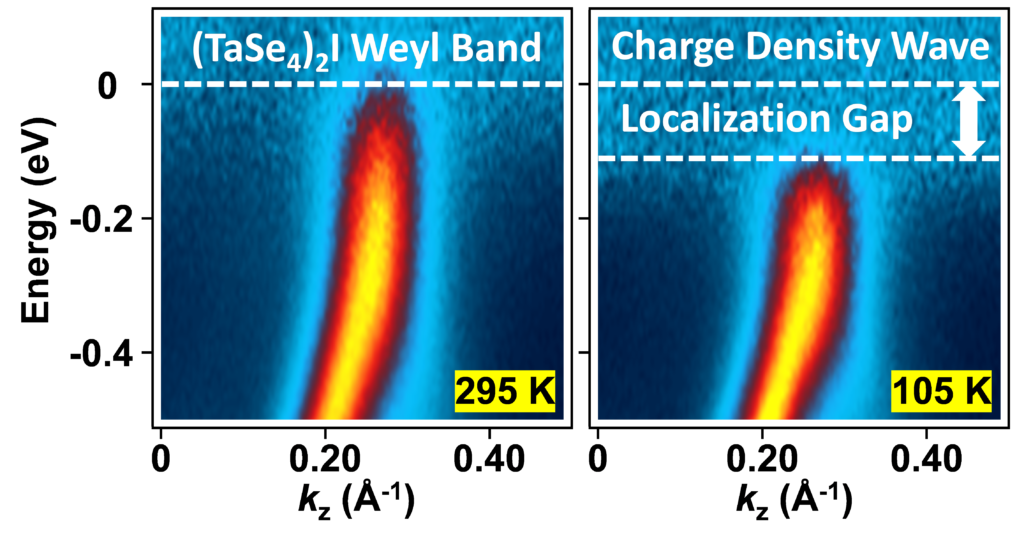
準一維外爾半金屬材料(TaSe4)2I之電荷密度波行為
Nano Letters 24, 8778 (2024)
Meng-Kai Lin*, Joseph Andrew Hlevyack, Chengxi Zhao, Pavel Dudin, José Avila, Sung-Kwan Mo, Cheng-Maw Cheng, Peter Abbamonte, Daniel P. Shoemaker, and Tai-Chang Chiang*
Unconventional Spectral Gaps Induced by Charge Density Waves in the Weyl Semimetal (TaSe4)2I
近幾年的理論指出,若外爾半金屬(Weyl semimetal)材料同時具備電荷密度波(Charge density wave)特性,電荷密度波相量有機會與外爾費米子間耦合,形成軸子絕緣體(axion insulator)。而準一維材料(TaSe4)2I是少數符合上述特性的材料,被認為是軸子絕緣體的候選材料。然而實驗上並未能提出直接的電荷密度波-外爾點交互作用證據,原因出自於此材料在溫度低於相轉變溫度時,靠近費米能階之光電子能譜訊號會急遽衰減,導致無法解析外爾點上是否有能隙產生。對於無法解析的費米能階附近能帶結構,過往的研究提出如axion insulator phases、correlation pseudogaps、polaron subbands、bipolaron bound states等解釋,然而這些解釋都會牽涉能隙的打開或能帶結構變化。我們運用角解析光電子能譜(Angle-resolved photoemission spectroscopy, ARPES)技術重新檢視此材料系統,並發現隨著樣品溫度的變化,能帶結構並沒有任何的變化,費米能階附近能帶結構的消失,是出自於樣品進入電荷密度波的相後,因為非相稱(incommensurate)電荷密度波特性,電荷密度波的週期並不跟晶格週期匹配,導致了準粒子的局域效應,進一步讓低能量激發之準粒子的動量資訊損失,此結果即是費米能階附近光電子能譜訊號急遽衰減的原因;此外,能帶結構並不隨溫度變化一事,也指出了此系統中並沒有電荷密度波-外爾點耦合效應,此材料並非軸子絕緣體的系統。
Coupling Weyl quasiparticles and charge density waves (CDWs) can lead to fascinating band renormalization and many-body effects beyond band folding and Peierls gaps. For the quasi-one-dimensional chiral compound (TaSe4)2I with an incommensurate CDW transition at TC = 263 K, photoemission mappings thus far are intriguing due to suppressed emission near the Fermi level. Models for this unconventional behavior include axion insulator phases, correlation pseudogaps, polaron subbands, bipolaron bound states, etc. Our photoemission measurements show sharp quasiparticle bands crossing the Fermi level at T > TC, but for T < TC, these bands retain their dispersions with no Peierls or axion gaps at the Weyl points. Instead, occupied band edges recede from the Fermi level, opening a spectral gap. Our results confirm localization of quasiparticles (holes created by photoemission) is the key physics, which suppresses spectral weights over an energy window governed by incommensurate modulation and inherent phase defects of CDW.
